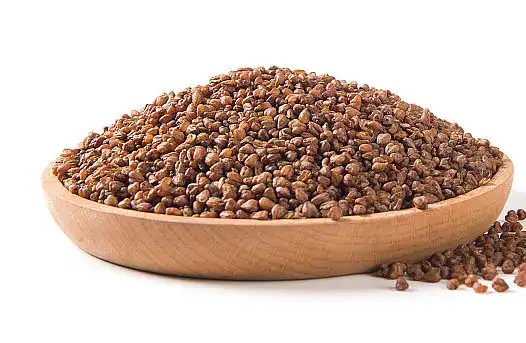What are the nutritional differences between Tartary Buckwheat and ordinary buckwheat extract?
2025-07-21 11:16:56
Buckwheat, a versatile pseudocereal, has been gaining popularity in recent years due to its impressive nutritional profile and potential health benefits. While common buckwheat (Fagopyrum esculentum) is widely known, there's another variety that's been capturing the attention of health enthusiasts and researchers alike – Tartary buckwheat (Fagopyrum tataricum). In this article, we'll delve into the nutritional differences between Tartary buckwheat extract and ordinary buckwheat extract, uncovering the unique properties that set these two varieties apart.

Is Tartary buckwheat extract more nutritious than regular buckwheat extract?
When it comes to comparing the nutritional profiles of Tartary buckwheat and ordinary buckwheat, it's essential to understand that both varieties offer significant health benefits. However, research suggests that Tartary buckwheat extract may have an edge in certain nutritional aspects.
Protein Content and Quality
Both Tartary and common buckwheat are renowned for their high-quality protein content. However, studies have shown that Tartary buckwheat contains slightly higher levels of protein compared to its common counterpart. This makes Tartary buckwheat extract a valuable ingredient for plant-based protein formulations and sports nutrition products.
Fiber Profile
Fiber is an essential component of a healthy diet, and both buckwheat varieties are excellent sources. Tartary buckwheat, however, has been found to contain a higher percentage of soluble fiber. This type of fiber is particularly beneficial for maintaining healthy cholesterol levels and promoting digestive health.
Phytochemical Composition
One of the most significant differences between Tartary and common buckwheat lies in their phytochemical profiles. Tartary buckwheat extract is notably richer in flavonoids, particularly rutin and quercetin. These powerful antioxidants contribute to the extract's potential health-promoting properties, including support for cardiovascular health and cellular protection.
Key vitamin and mineral comparisons between buckwheat varieties
While both Tartary and common buckwheat are nutrient-dense, there are some notable differences in their vitamin and mineral content. Understanding these variations can help formulators and product developers make informed decisions when choosing between the two extracts.
Vitamin B Complex
Buckwheat, in general, is a good source of B vitamins. However, Tartary buckwheat has been found to contain higher levels of certain B vitamins, particularly thiamine (B1) and riboflavin (B2). These vitamins play crucial roles in energy metabolism and cellular function, making Tartary buckwheat extract an attractive option for energy-boosting formulations.
Mineral Content
Both buckwheat varieties are rich in essential minerals, but Tartary buckwheat stands out in a few key areas:
- Iron: Tartary buckwheat contains significantly higher levels of iron compared to common buckwheat. This makes it a valuable ingredient for products aimed at supporting healthy blood formation and oxygen transport.
- Zinc: While both varieties contain zinc, Tartary buckwheat has been shown to have a higher zinc content. Zinc is essential for immune function and wound healing.
- Magnesium: Tartary buckwheat is particularly rich in magnesium, which is crucial for numerous bodily functions, including muscle and nerve function, bone health, and energy production.
Antioxidant Minerals
Tartary buckwheat contains higher levels of selenium and manganese compared to common buckwheat. These minerals act as cofactors for important antioxidant enzymes in the body, further enhancing the extract's potential protective effects.
Why Tartary buckwheat Extract has higher antioxidant levels?
One of the most notable attributes of Tartary buckwheat extract is its exceptionally high antioxidant content. Understanding the reasons behind this can help appreciate its value in various applications, from nutraceuticals to functional foods.
Unique Flavonoid Profile
The superior antioxidant capacity of Tartary buckwheat can be largely attributed to its unique flavonoid profile. Tartary buckwheat contains significantly higher levels of rutin compared to common buckwheat. Rutin is a powerful antioxidant that has been associated with numerous health benefits, including support for cardiovascular health and potential anti-inflammatory properties.
Environmental Adaptations
Tartary buckwheat's higher antioxidant content may be a result of its ability to thrive in harsh environmental conditions. This variety is often grown in high-altitude regions with intense UV radiation and temperature fluctuations. To protect itself from these stressors, the plant produces higher levels of antioxidant compounds, which translate into a more potent extract.
Synergistic Effects
The antioxidant power of Tartary buckwheat extract isn't just about individual compounds. The synergistic effects of various antioxidants, including flavonoids, phenolic acids, and vitamins, contribute to its overall higher antioxidant capacity compared to ordinary buckwheat extract.
Conclusion
In conclusion, while both Tartary and common buckwheat extracts offer valuable nutritional benefits, Tartary buckwheat stands out in several key areas. Its higher protein content, unique fiber profile, and exceptional antioxidant levels make it a compelling ingredient for a wide range of applications in the health and wellness industry.
Are you looking to enhance your product line with high-quality, nutrient-rich ingredients? YTBIO specializes in providing premium organic plant-based ingredients, including Tartary buckwheat extract, to meet the growing demand for natural, health-promoting products. Whether you're a nutraceutical company seeking standardized herbal extracts, a functional beverage maker in need of potent antioxidants, or a health food brand looking for clean-label protein sources, YTBIO has the expertise and products to support your needs. Our organic certifications, including USDA NOP and EU EC, along with our rigorous quality control standards (GAP, GMP, HACCP, ISO, Kosher, Halal), ensure that you're getting the highest quality ingredients for your formulations. Don't miss out on the opportunity to elevate your products with the power of Tartary buckwheat. Contact us today at sales@sxytorganic.com to learn more about how our organic plant-based ingredients can benefit your business.
References
1. Zhang, L., et al. (2019). Tartary buckwheat (Fagopyrum tataricum Gaertn.) as a source of dietary rutin and quercitrin. Journal of Agricultural and Food Chemistry, 67(4), 1252-1259.
2. Bonafaccia, G., et al. (2003). Trace elements and functional compounds in Tartary buckwheat. Food Chemistry, 83(1), 1-5.
3. Kreft, I., et al. (2020). Tartary Buckwheat (Fagopyrum tataricum Gaertn.) as a Source of Dietary Rutin and Quercitrin. Journal of Agricultural and Food Chemistry, 68(39), 10795-10803.
4. Tomotake, H., et al. (2006). Comparison between buckwheat protein and soy protein in cholesterol-lowering effects in rats. Journal of Nutritional Science and Vitaminology, 52(6), 394-399.
5. Zhu, F. (2016). Chemical composition and health effects of Tartary buckwheat. Food Chemistry, 203, 231-245.
6. Guo, X., et al. (2017). Health benefits of Tartary buckwheat. Critical Reviews in Food Science and Nutrition, 57(14), 3060-3071.
_1737093401309.png)
